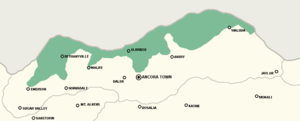Insurgency in Ancora: Difference between revisions
m (Fixing ranks, updating info) |
mNo edit summary |
||
| Line 33: | Line 33: | ||
*[[File:KarnaliFlag.png|25px]] Narendra Khanal ♰ | *[[File:KarnaliFlag.png|25px]] Narendra Khanal ♰ | ||
| commander3 = | | commander3 = | ||
| units1 = {{team flag|Aerla}} [[Grand Army of Aerla]] | | units1 = {{team flag|Aerla|flag}} [[Grand Army of Aerla]] | ||
*2nd Home Army | *2nd Home Army | ||
**Citizen's Militias | **Citizen's Militias | ||
Revision as of 17:23, 11 August 2023
| Insurgency in Ancora | |||||||
|---|---|---|---|---|---|---|---|
 Areas held by rebel insurgents at the start of the conflict |
|||||||
|
|||||||
| Belligerents | |||||||
| Commanders and leaders | |||||||
| Units involved | |||||||
| Guerrilla and Partisan Forces | ||||||
| Strength | |||||||
| 22,000 | Unknown | ||||||
The Insurgency in Ancora is an armed conflict in the Aerlan municipality of Ancora. The conflict broke out after sporadic riots and violence in the region by the ethnic Karnali minority.
Background
The Karnali have inhabited the lands of Aerla since ancient times. After many centuries of internal migration, most remaining Karnali settled within what are now the northern municipalities, with the bulk of them settling in the Ancora Municipality. During the unification of Aerla, a vocal minority of ethnic Karnali opposed the annexation of their lands into the young republic. However, due to the lack of unity of their settlements, they were powerless to stop their incorporation.
In late 1712 AN, two local leaders named Kalyan Sinjali and Narendra Khanal called for a meeting of ethnic Karnalis who wished to break away from Aerla and form a new Karnali state. Original plans consisted of calling for a mass exodus of Karnali to The Green to form a new state, however the group came to the conclusion that such state would simply be ran over by the Aerlan military, as such plans would not be backed by the general populace. Such, they declared that they would call for a general uprising of Karnali who wished to take up arms against the Aerlan Government.
Beginning of Violence
Seeming coordinated riots soon began in major population centers in the Ancora, the most deadly of these being in which a detail of Criminal Police officers where stabbed and beaten to death in their precinct in Bethanyville. The governments first response to these incidents were light, and more police and some militia forces were sent to the region. By this point, however, the banner of the ancient Karnali state were raised in many areas of the municipality, and guerrillas soon began gathering arms and began advancing on population centers. They quickly took over the towns of Bethanyville and Elkridge, and began batlling local citizen militias in the towns of Malks and Waluda. With the prospect of more towns falling to the enemy, the 2nd Army of the Grand Army of Aerla was mobilized and sent north via train.
Initial Battles
The first divisions to arrive in Ancora set up defensive positions in Ancora Town and Emerson, and were able to stave off attacks by guerrillas. Other divisions set off the reinforce the Civilian Militias in Waluda and Malke. The fighting in Waluda was noted for being especially fierce, as the guerrillas had entrenched themselves in numerous positions in and around the town. Causalities were heavy on both sides, and reports soon flooded in of Aerlan soldiers laying down their arms and fleeing the battlefield en masse.
After several days of fighting, Karnali forces were successfully repelled from the town of Malks and driven several kilometers into the surrounding countryside. Attacks on Emerson, Avery, and Ancora Town were also successfully repelled. In response of this, several car bombings were orchestrated by insurgent forces in Malks and in the town of Dalen.
Operation Sabretooth
After consideration by those in the GAR's high command, it was decided that a swift capture of all major Karnali bases of power was necessary. This would be done in conjunction with SSD agents, who would infiltrate the ranks of the insurgency, and undermine their response. The operation would consist of a three-pronged attack: Generalmajor Aaron Kamensky would lead an army to capture Bethanyville, after which his forces would recapture insurgent territory on their way link up with Generalmajor Charles Escher in capturing Elkridge. Then, this combined force would march their way through the countryside on their way to aid in the capture of Waluda, which would be under siege by General-ov-ArtilaryTerrance Gerhardt.
- Attack against Bethanyville successful, captured in 1 weeks time
- Prolonged battle in Elkridge, Karnali insurgents but on backfoot by Kamensky's arrival
- Narendra Khanal's "staff car" blown up by SSD agents on Elkridge-Waluda road, Khanal killed
- Several massacres take place on march to Waluda
- Combined Kamensky-Escher forces arrive to relieve siege at Waluda
- Tabun gas used en-masse against Waluda's defenders
- Waluda captured, Kalyan Sinjali surrenders
Aftermath
The GAR's response to the insurgency was heavily scrutinized by the general public and the Aerlan Government. Many officers within the army were demoted and stripped of their honors. Cassian himself received much criticism from those in the government and army for a supposed lack of involvement in the early stages of the conflict. He was blamed by many for causing the insurgency to go from a simple "peasant rebellion" into a full insurgency.
Most of those who fought against the Aerlan government were given amnesty by the nation's courts. Higher profile individuals were tried on a case by case basis. The highest ranking member put on trial was the leader of the insurgency himself, Kalyan Sinjali. Sinjali was sentenced to execution, and he was shot by a firing squad.
Over the coming decade, the Karnali population of Aerla would go on to steadily decrease. By 1723 AN, it was estimated only around 15,000 Karnali remained within the Republic’s border.
